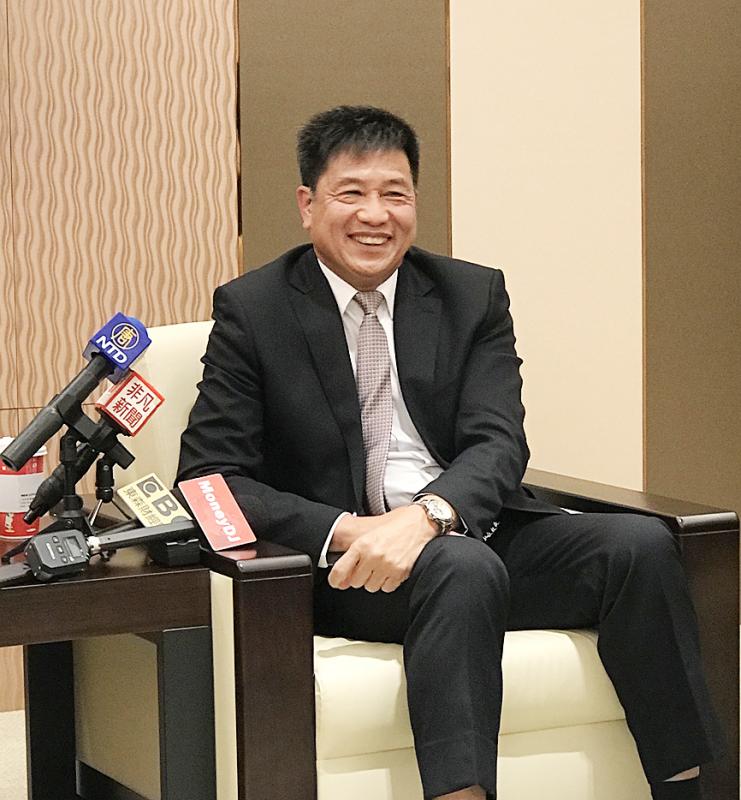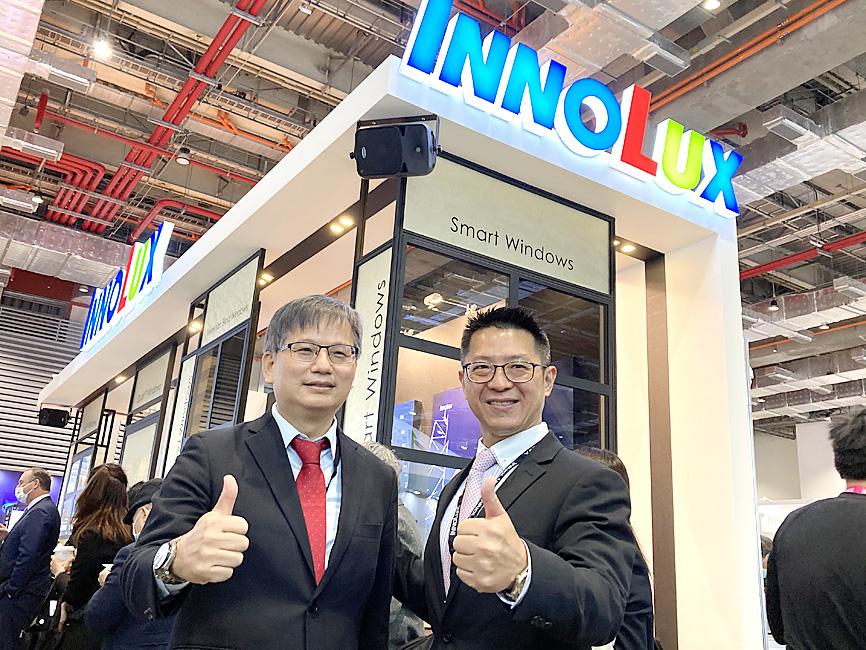LCD panel makers Innolux Corp (群創) and AU Optronics Corp (AUO, 友達光電) yesterday said that water restrictions do not threaten their production, as they have increased their usage of reclaimed water.
Innolux and AUO said that they recycle more than 95 percent of their wastewater and use it for flat-panel manufacturing, helping to them minimize the effects of the water shortage.
The companies said that they are well-prepared for more stringent water conservation measures, as they have signed supply contracts with private suppliers to transport water to their factories using tank trucks.

Photo: Chen Mei-ying, Taipei Times
As water supply remains stable, no trucks have been commissioned yet, the companies said.
“We have planned ahead for any contingency. It is still manageable if the water restrictions deepen to 15 percent, from 11 percent recently and 7 percent at the beginning [of this year],” Innolux president James Yang (楊祝祥) told reporters on the sidelines of the Smart City Summit and Expo at the Taipei Nangang Exhibition Center’s Hall 2.
Innolux also sought help from the Tainan City Government to find an alternative water source, Yang said.

Photo: Lisa Wang, Taipei Times
The company has signed an agreement with the city government to use reclaimed water from households, he said.
In addition to reducing water supply during the severe drought, the Ministry of Economic Affairs also plans to impose water surcharges on major water users, such as panel makers, as early as next year, which would push up manufacturers’ costs.
Innolux plans to talk with customers about sharing the extra costs, company chairman Jim Hung (洪進揚) said.
The water supply issue is less of a problem than the shortage of chips used in flat panels, Yang said.
Driver ICs, touch sensors, and power management chips and glasses are in short supply, Innolux said early this month.
Tight supply of key components would affect shipments slightly this quarter, the company said.
Overall, Innolux is optimistic about customer demand, and order visibility is very clear, Hung said, adding that panel prices are likely to continue rising in the second half of this year.
Panel demand has surpassed supply as telecommuting, remote learning and stay-at-home trends have boosted demand for notebook computers and small-sized TVs amid the COVID-19 pandemic, Innolux said.
“I think we have relatively better pricing power this year,” Hung said.
Separately, AUO said that it is scouting sites overseas to build new panel module assembly lines in response to customer demand, especially from the automobile segment.
The company plans to build a plant in North America and is also considering constructing plants in Europe and Southeast Asia, AUO chairman Paul Peng (彭双浪) told reporters at a news conference.

TECH BOOST: New TSMC wafer fabs in Arizona are to dramatically improve US advanced chip production, a report by market research firm TrendForce said With Taiwan Semiconductor Manufacturing Co (TSMC, 台積電) pouring large funds into Arizona, the US is expected to see an improvement in its status to become the second-largest maker of advanced semiconductors in 2027, Taipei-based market researcher TrendForce Corp (集邦科技) said in a report last week. TrendForce estimates the US would account for a 21 percent share in the global advanced integrated circuit (IC) production market by 2027, sharply up from the current 9 percent, as TSMC is investing US$65 billion to build three wafer fabs in Arizona, the report said. TrendForce defined the advanced chipmaking processes as the 7-nanometer process or more

China’s Huawei Technologies Co (華為) plans to start mass-producing its most advanced artificial intelligence (AI) chip in the first quarter of next year, even as it struggles to make enough chips due to US restrictions, two people familiar with the matter said. The telecoms conglomerate has sent samples of the Ascend 910C — its newest chip, meant to rival those made by US chipmaker Nvidia Corp — to some technology firms and started taking orders, the sources told Reuters. The 910C is being made by top Chinese contract chipmaker Semiconductor Manufacturing International Corp (SMIC, 中芯) on its N+2 process, but a lack

NVIDIA PLATFORM: Hon Hai’s Mexican facility is to begin production early next year and a Taiwan site is to enter production next month, Nvidia wrote on its blog Hon Hai Precision Industry Co (鴻海精密), the world’s biggest electronics manufacturer, yesterday said it is expanding production capacity of artificial intelligence (AI) servers based on Nvidia Corp’s Blackwell chips in Taiwan, the US and Mexico to cope with rising demand. Hon Hai’s new AI-enabled factories are to use Nvidia’s Omnivores platform to create 3D digital twins to plan and simulate automated production lines at a factory in Hsinchu, the company said in a statement. Nvidia’s Omnivores platform is for developing industrial AI simulation applications and helps bring facilities online faster. Hon Hai’s Mexican facility is to begin production early next year and the

Who would not want a social media audience that grows without new content? During the three years she paused production of her short do-it-yourself (DIY) farmer’s lifestyle videos, Chinese vlogger Li Ziqi (李子柒), 34, has seen her YouTube subscribers increase to 20.2 million from about 14 million. While YouTube is banned in China, her fan base there — although not the size of YouTube’s MrBeast, who has 330 million subscribers — is close to 100 million across the country’s social media platforms Douyin (抖音), Sina Weibo (新浪微博) and Xiaohongshu (小紅書). When Li finally released new videos last week — ending what has